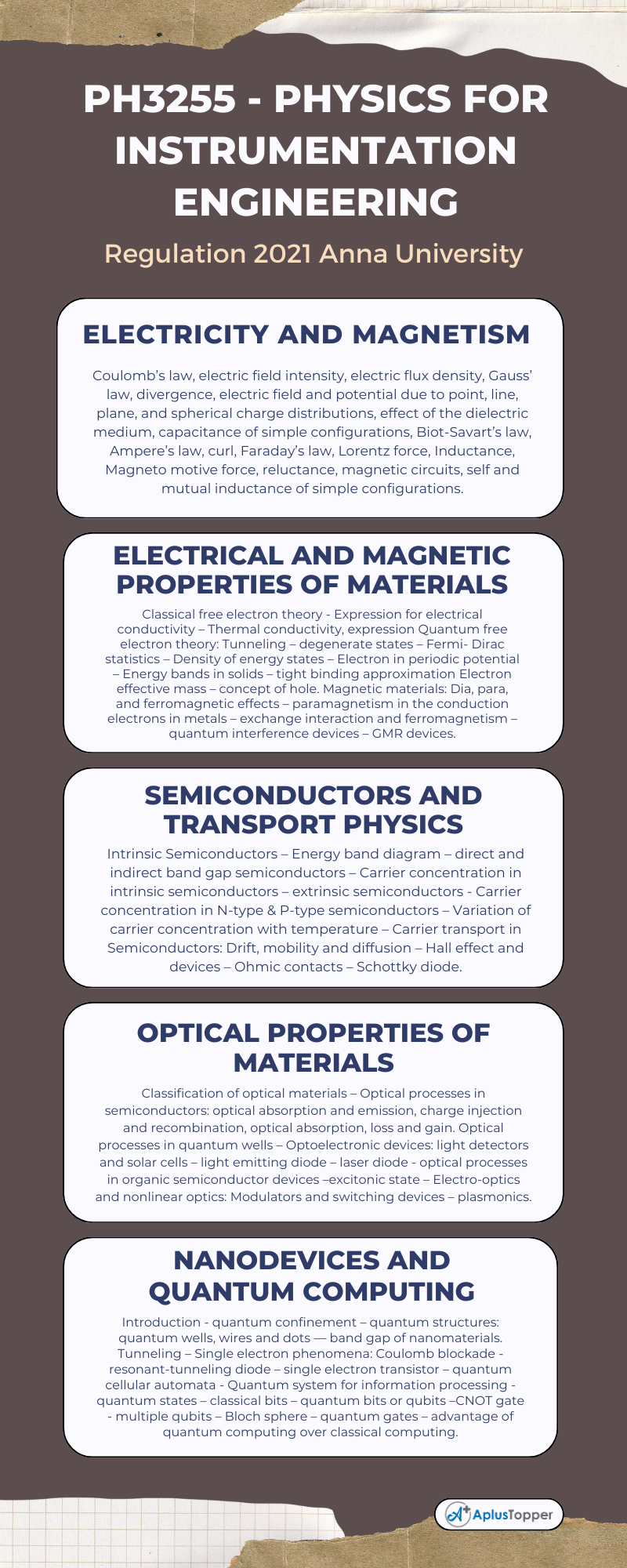Physics For Instrumentation Engineering Subject from the Semester II B.E Electrical and Instrumentation Of Anna University syllabus. In this article, we aim to provide the unit-wise topics in a detailed manner.
We added the required textbooks and references from the faculty. It will assist you in making preparation strategies for the examination. Having a grip on every topic of the unit you can able to finish the syllabus before everyone else. Hope this information is useful. If you have any queries about the syllabus of PH3255 – Physics For Instrumentation Engineering. Comment below on this article.
If you want to know more about the B.E Electrical and Instrumentation syllabus connected to an affiliated institution’s four-year undergraduate degree program. We provide you with a detailed Year-wise, semester-wise, and Subject-wise syllabus in the following link B.E Electrical and Instrumentation Syllabus Regulation 2021 Anna University.
Aim Of Concept:
- To make the students to understand the basics of electricity and magnetism and vectors.
- To understand the electrical properties of materials including free electron theory, applications of quantum mechanics and magnetic materials.
- To instil knowledge on physics of semiconductors, determination of charge carriers and device applications
- To establish a sound grasp of knowledge on different optical properties of materials, optical displays and applications
- To inculcate an idea of significance of nano structures, quantum confinement and ensuing nano device applications.
PH3255 – Physics For Instrumentation Engineering Syllabus
Unit I: Electricity And Magnetism
Coulomb’s law, electric field intensity, electric flux density, Gauss’ law, divergence, electric field and potential due to point, line, plane, and spherical charge distributions, effect of the dielectric medium, capacitance of simple configurations, Biot-Savart’s law, Ampere’s law, curl, Faraday’s law, Lorentz force, Inductance, Magneto motive force, reluctance, magnetic circuits, self and mutual inductance of simple configurations.
Unit II: Electrical And Magnetic Properties Of Materials
Classical free electron theory – Expression for electrical conductivity – Thermal conductivity, expression Quantum free electron theory: Tunneling – degenerate states – Fermi- Dirac statistics – Density of energy states – Electron in periodic potential – Energy bands in solids – tight binding approximation Electron effective mass – concept of hole. Magnetic materials: Dia, para, and ferromagnetic effects – paramagnetism in the conduction electrons in metals – exchange interaction and ferromagnetism – quantum interference devices – GMR devices.
Unit III: Semiconductors And Transport Physics
Intrinsic Semiconductors – Energy band diagram – direct and indirect band gap semiconductors – Carrier concentration in intrinsic semiconductors – extrinsic semiconductors – Carrier concentration in N-type & P-type semiconductors – Variation of carrier concentration with temperature – Carrier transport in Semiconductors: Drift, mobility and diffusion – Hall effect and devices – Ohmic contacts – Schottky diode.
Unit IV: Optical Properties Of Materials
Classification of optical materials – Optical processes in semiconductors: optical absorption and emission, charge injection and recombination, optical absorption, loss and gain. Optical processes in quantum wells – Optoelectronic devices: light detectors and solar cells – light emitting diode – laser diode – optical processes in organic semiconductor devices –excitonic state – Electro-optics and nonlinear optics: Modulators and switching devices – plasmonics.

Unit V: Nanodevices And Quantum Computing
Introduction – quantum confinement – quantum structures: quantum wells, wires and dots –– band gap of nanomaterials. Tunneling – Single electron phenomena: Coulomb blockade – resonant-tunneling diode – single electron transistor – quantum cellular automata – Quantum system for information processing – quantum states – classical bits – quantum bits or qubits –CNOT gate – multiple qubits – Bloch sphere – quantum gates – advantage of quantum computing over classical computing.
Text Books:
- S.O. Kasap. Principles of Electronic Materials and Devices, McGraw Hill Education (Indian Edition), 2020.
- R.F.Pierret. Semiconductor Device Fundamentals.Pearson (Indian Edition), 2006.
- G.W.Hanson. Fundamentals of Nanoelectronics.Pearson Education (Indian Edition), 2009.
References:
- Matthew N. O. Sadiku, Principles of Electromagnetics, Oxford Univ. Press 2015.
- Jasprit Singh, Semiconductor Optoelectronics: Physics and Technology, McGraw-Hill Education (Indian Edition), 2019.
- Charles Kittel, Introduction to Solid State Physics, Wiley India Edition, 2019.
- Mark Fox, Optical Properties of Solids, Oxford Univ.Press, 2001.
- Parag K. Lala, Quantum Computing: A Beginner’s Introduction, McGraw-Hill Education (Indian Edition), 2020.
Related Posts On Semester – II:
- HS3252 – Professional English – II
- MA3251 – Statistics and Numerical Methods
- BE3255 – Basic Civil and Mechanical Engineering
- GE3251 – Engineering Graphics
- EE3251 – Electric Circuit Analysis
- GE3252 – Tamils and Technology
Must Read For More:
